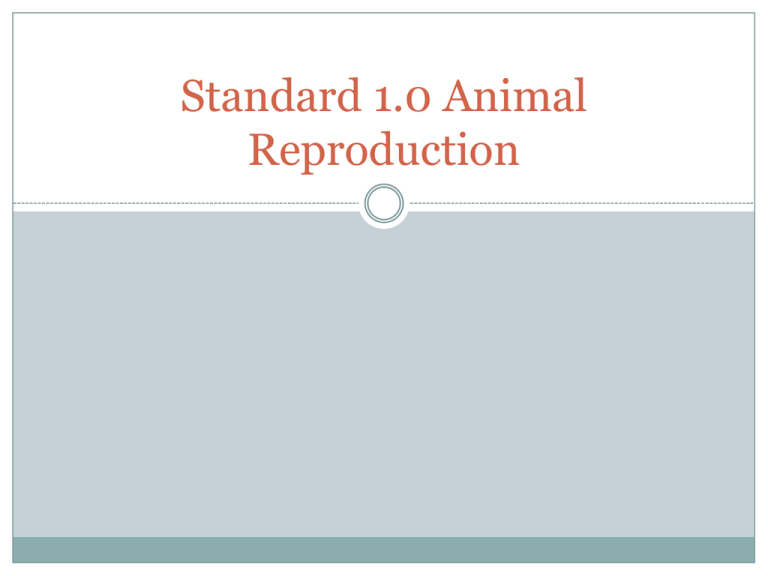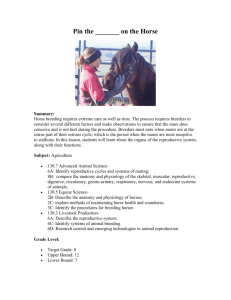Standard 1.0 Animal Reproduction
advertisement

Standard 1.0 Animal Reproduction Objectives 1.1.1 Analyze the male reproductive organs and their functions. 1.1.2 Analyze the female reproductive organs and their functions. 1.1.3 Analyze the estrous cycle in common livestock. 1.2.1 Compare and explain natural breeding methods in animals. 1.2.2 Assess artificial breeding methods in animals. Objectives 1.2.3 Discuss the advantages and disadvantages of natural breeding and artificial breeding. 1.2.4Assess and analyze the materials, methods and processes of artificial insemination. 1.3.1 Assess the advantages of major reproductive management practices including estrous synchronization, superovulation, flushing and embryo transfer. 1.3.2 Analyze the process of major reproductive management practices including estrous synchronization, superovulation, flushing and embryo transfer. Terms 1. artificial insemination- The injection of semen into the uterus other than by natural mating. 2. cervix- The narrow neck like passage forming the lower end of the uterus 3. copulation- the mating of a male and female 4. corpus luteum- a reddish-yellow mass that forms in a ruptured follicle in the ovary of mammals; the hormone progesterone is released by the corpus luteum Terms 5. diestrus- A period of sexual inactivity between recurrent periods of estrus. 6. embryo transfer- moving an embryo from one female animal to another of the same species 7. estrogen- a hormone produced by the ovaries 8. estrous cycle-the time between periods of estrous 9. estrous synchronization-Using synthetic hormones to make a group of females come in heat at the same time. Terms 10. estrus- the time during which the female will accept the male for copulation; also referred to as being “in heat” 11. follicle- a small blister-like development on the surface of the ovary that contains the developing ovum 12. follicle stimulating hormone- a hormone produced by the pituitary gland that promotes growth of ovarian follicles in the female and sperm in the male 13. gestation-the time during which the animal is pregnant 14. hormone- an organic material given off by a body gland that helps regulate body functions Terms 15. metestrus-the luteal phase of the reproductive cycle in mammalian females, occurring after ovulation and characterized by development of the corpus luteum, increased progesterone secretion, and decreased estrogen secretion. 16. ovary- A female reproductive organ in which ova or eggs are produced 17. ovulation- the release of the egg from the ovary 18. oxytocin- a hormone that causes contractions of the uterus during breeding and parturition and causes milk letdown Terms 19. parturition- the act of giving birth 20. penis- The male genital organ of higher vertebrates, carrying the duct for the transfer of sperm during copulation. 21. proestrus- The period immediately before estrus in most female mammals, characterized by development of the endometrium and ovarian follicles. 22. progesterone- a hormone produced by the ovaries that maintains pregnancy in the animal Terms 23. scrotum- A pouch of skin containing the testicles 24. superovulation- the stimulation of more than the usual number of ovulations during a single estrous cycle due to the injection of certain hormones. 25. testis- An organ that produces spermatozoa 26. testosterone- a male hormone that controls the traits of the male animal Terms 27. uterus- The organ in the lower body of a female mammal where offspring are conceived and in which they gestate before birth 28. vagina-The muscular tube leading from the external genitals to the cervix of the uterus 29. zygote- a cell formed by the union of two gametes 1.1.1 Analyze the male reproductive organs and their functions. What are the major reproductive organs in male mammals? What are the functions of those organs? To have a successful livestock operation, a producer must have an understanding of the various reproductive organs and their functions. In most cases, a livestock operation will have only a limited number of males available for breeding. The male reproductive system contains several interconnected parts that must all work together for successful mating. Testicles or Testis The testicles or testis produce sperm, the male sex cells (also called spermatozoa). They also produce a hormone called testosterone that causes the appearance and behavior of the animal to be masculine. Two testicles are present in male mammals. Epididymis The Epididymis is the storage site for sperm cells. From the testicle, these cells enter the epididymis to mature. Sperm can fertilize a female’s ova (female sex cell) as it travels through the epididymis. A separate epididymis is attached to each testicle. Scrotum The Scrotum is a two-lobed sac that contains and protects the two testicles. It also regulates the temperature of the testicles, which is lower than the body temperature. When the environment temperature is low, the scrotum contracts, pulling the testicles toward the body and its warmth. Maintaining the correct temperature is critical because extreme temperatures (too hot or too cold) can affect the production and vitality of sperm What are the major reproductive organs in male mammals? Vas deferens—The vas deferens is essentially a transportation tube that carries the spermcontaining fluid from each epididymis to the urethra. Urethra—The urethra is a large, muscular canal extending from the urinary bladder. Both semen and urine move through the urethra to the end of the penis. What are the major reproductive organs in male mammals? The penis deposits the semen within the female reproductive system. The urethra in the penis is surrounded by spongy tissue that fills with blood when the male is sexually aroused, which causes an erection that is necessary for copulation (mating) to occur. The sigmoid flexure (found in bulls, rams, and boars) and the retractor muscle extend the penis from the sheath, which is a tubular fold of skin. Horses and other mammals do not have a sigmoid flexure. 1.1.2 Analyze the female reproductive organs and their functions. 1.1.2 Analyze the female reproductive organs and their functions. The ovary produces female gametes, which are sex cells that can unite with other sex cells. These are called ova (eggs). A female mammal will typically have two ovaries, which also produce the female sex hormones: estrogen and progesterone. Within each ovary, there are hundreds of tiny follicles or cavities. The ova are produced in the follicles. Each ovum is the largest single cell in the body. 1.1.2 Analyze the female reproductive organs and their functions. The uterus of mammals is a Yshaped structure consisting of the body, two uterine horns, and the cervix. Size and shape of uterus varies on each mammal. The upper part of the uterus consists of the two uterine horns. 1.1.2 Analyze the female reproductive organs and their functions. The cervix is the lower outlet of the uterus and is composed primarily of connective tissue that constitutes the gateway between the uterus and the vagina. 1.1.2 Analyze the female reproductive organs and their functions. The vagina serves as the female organ of copulation at mating and as the birth canal at parturition. It is the passage between the cervix and the vulva. The lining is moist during estrus and dry when the animal is not in estrus. 1.1.3 Analyze the estrous cycle in common livestock. Phases of the Estrous Cycle in Cattle Estrus (Day 1) Cow stands to be mounted The female will accept the male. Mucous discharge from increased mucous production Progesterone production is low Lutenizing hormone (LH) spikes to a high which stimulates ovulation Phases of the Estrous Cycle in Cattle Metestrus (Days 2-6) Ovulation occurs Corpus Luteum (CL) starts developing Ovulation-release of the egg. corpus luteum- a reddish-yellow mass that forms in a ruptured follicle in the ovary of mammals; the hormone progesterone is released by the corpus luteum Bloody discharge Progesterone levels start increasing as CL develops Prostaglandin is not effective in stopping the CL (lysing the CL) in this stage, therefore prostaglandin is ineffective at restarting the cycle during this phase Phases of the Estrous Cycle in Cattle Diestrus (Days 7-18) CL is producing increasing amounts of progesterone CL matures Prostaglandin will lyse (stop) the CL and initiate a return to estrus during this phase Phases of the Estrous Cycle in Cattle Proestrus (Days 18-21) (If fertilization occurred) Progesterone will continue to be produced at high levels and will protect the embryo throughout the pregnancy Embryo will embed in to the wall of the uterus and fetus will develop (If fertilization did not occur) The CL will begin to regress As the CL regresses, progesterone levels will also start to decrease allowing the Lutenizing Hormone (LH) and estrogen levels to increase Because the CL is already decreasing, prostaglandin may be ineffective during this phase as well 1.2.1 Compare and explain natural breeding methods in animals. REPRODUCTIVE PROCESSES OF AGRICULTURAL ANIMALS Beef Cattle Age at Puberty: 8-15 Months Ovulate on an estrous cycle (18-24 days) Gestation Length: 9 months Parturition Copulation Sheep/Goats Age at Puberty: 5-6 Months Ovulate on an estrous cycle (16-18 days) (Affected by day length) Gestation Length: 5 months Parturition Copulation Pigs Age at Puberty: 5-6 Months Ovulate on an estrous cycle (19-22 days) Gestation Length: 3 months, 3 weeks, 3 days Parturition/Farrowing Copulation Horses Age at Puberty: 12-18 Months Ovulate on an estrous cycle (18-24 days) Gestation Length: 11 months Parturition Copulation Rabbits Age at Puberty: 6 Months Induced ovulators (ovulate after mating occurs) Gestation Length: 30 days Parturition Copulation Llama/Alpaca Age at Puberty: 20-24 Months Induced ovulators (ovulate after mating occurs) Gestation Length: 12 months Parturition Copulation Chicken Age at Puberty: 4-6 Months Release egg on regular cycle (24 hours) Incubation Length: 21 days Hatching Copulation 1.2.2 Assess artificial breeding methods in animals. WHAT IS ARTIFICIAL INSEMINATION? 1.2.2 Assess artificial breeding methods in animals. Artificial insemination is the placing of semen in the female reproductive tract by artificial techniques. The use of this technique has increased over the past several years due to advancements in technology. The process varies by species, but it typically involves specialized equipment and a trained technician.






